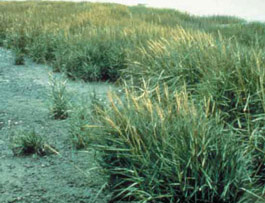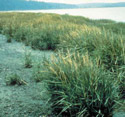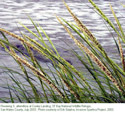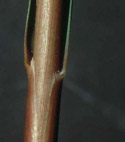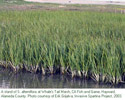Smooth Cordgrass
Spartina alterniflora • Class A |
||
| Family Name: | Gramineae Family (gram-IN-ay-ee) | |
| Common: | Poaceae family, True Grasses | |
| Genus: |
Spartina (spar-TEE-nuh) Meaning: From the Greek meaning a cord made from this grass |
|
| Species: |
alterniflora (al-tern-ih-FLOR-uh) Meaning: Alternating flowers |
|
| Description: |
This long-lived, deciduous perennial typically grows from 2 to 7 feet tall and spreads extensively by long hollow rhizomes. Hollow, hairless stems up to 1/2 inch in diameter emerge from the rhizomes and die back at the end of the growing season. The flat leaf blades are from 12 to 20 inches long and tapered to a long inward-rolled tip. Ligules consist of a fringe of hair. Flowers are borne on a spike-like infloresence and are inconspicuous. In Sept. and Oct. seed heads emerge at the end of the stem and are 10 to 12 inches long. |
| Why Is it a Noxious Weed? |
Smooth cordgrass is an aggressive exotic salt marsh plant. It is highly invasive and considered to be one of the most aggressive weeds worldwide. It displaces native species, destroys habitat and food sources for fish, waterfowl and other marine life. It also interferes with recreational activities. |
| Where Does it Grow? |
Found in intertidal zones, where it colonizes mud or sand-flats, in salt or brackish water. |
| Facts: |
Because of its ability to trap sediment, Spartina species have the potential to change the fundamental nature of portions of Washington's coastline. A secondary impact of this increased sediment may be changes in water circulation patterns, reducing tidal flow and leading to increased flooding at, or in the mouths of rivers. |
| Control Options: |
|
| More Information: |
Download our Flyer or visit Washington State Noxious Weed Control Board Here. Photo by Leo Michels
|
| More Pictures: |
